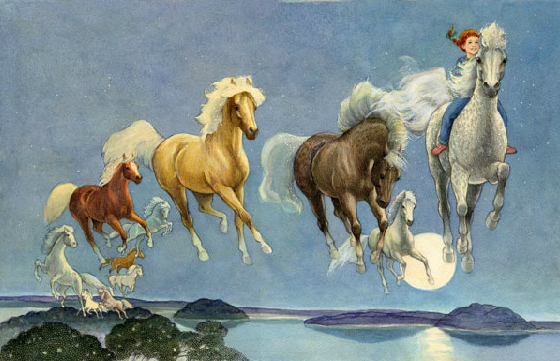bleed the presidents poor
grand
for a flying
Persian
and 4 years, 1 book,
one-half manuscript
later
the thing
sputters
onto the median
ingesting poems
and
vomiting
error reports
kick in another
half G
and watch profit
on paper bleed the
presidents poor
swear unholy
the proxy cursor
and the castrating horse
it rode in on

-- Susan Jeffers
"To pony up" is an American expression meaning to pay money; the expression came from 16th century slang for "money," from the Latin "legem pone," the first two words of Psalm 119:33, the Psalm for 25 March, the first payday of the year. The “flying Persians” are the ”castrating horses” that Wanda refers to. There is no separate breed of Persians, but equines have always been a key element of Persian culture. Cyrus the Great created the Persian empire essentially on the backs of his Median horses. Herodotus wrote of the beauty of the white Nisean horses that kings and generals rode to demonstrate their wealth and authority. (“Median” should not be confused with “median,” in this case the strip between lanes of traffic, a usage that dates from 1954 but goes back in English to the 1590s as an anatomical term used in conjunction with veins, arteries, and nerves; from the Latin “medianus" -- of the middle.)
ReplyDeleteA “G” is a grand, a slang word for a thousand-dollar bill (or $1,000; the US no longer prints bills valued at over $100). In the 15th century the English adopted the Old French word “grant” (ultimately from the Latin “grandis,” great or large) as “grand,” meaning large, imposing, great, famous, exalted, or important. Around 1915 “grand” was used in American criminal argot to mean $1,000, which was a great deal of money at the time; at around the same time, “c-note” designated a hundred-dollar bill (from the Roman numeral “C,”100), and a “sawbuck” designated a ten-dollar bill, from the resemblance of a sawhorse to the Roman numeral “X.” 10). The US began circulating high-denomination banknotes in 1862 to finance the Civil War. Most often, American currency has featured portraits of American presidents (George Washington on $1 bills, Thomas Jefferson $2, Abraham Lincoln $5, Andrew Jackson $20, Ulysses S. Grant $50; earlier, William McKinley was on the $500 bill, Grover Cleveland on the $1,000, James Madison on the $5,000, and Woodrow Wilson on the $100,000 (actually, a gold certificate that was only printed over a three-week period in 1934-1935 and used only for official transactions between the treasurer of the US and those Federal reserve banks that had at least that amount of gold in the treasury). A few banknotes honored non-presidents (Alexander Hamilton, the nation’s first secretary of the treasury, on the $10—and for a time on the $2 and $1,000 denominations, Benjamin Franklin on the $100, Salmon P. Chase, the treasury secretary during the Civil War, on the $10,000.) It was Chase who introduced the “greenbacks” in 1861 to expedite liquidity during the Civil War; part of his job was to design the new currency, so he put his own face on the new $1 bills in order to advance his presidential ambitions. The last high-denomination bills were printed in 1945 and officially discontinued in 1969, though they are still legal tender.